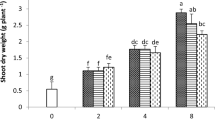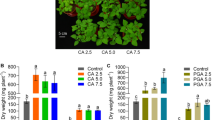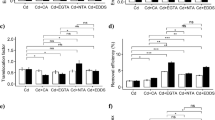Abstract
Solution culture was carried to investigate capacity of synthetic aminopolycarboxylic acids (ethylenediamine tetraacetate, N-hydroxyethylenediaminetriacetic acid, and diethylenetriamine-pentaacetate) for enhancing botanical removal and transport of heavy metals (Cu and Zn) by plants. Biodegradable organic acids (citric acid, malic acid, and oxalic acid) were also selected as alternatives to compare them with synthesized chelating agents for effectiveness. Young rice seedlings (Oryza sativa L. cv. XZX 45) were grown in nutrient solutions treated with single or combined metal solutions in presence or absence of chelating compounds. Calculation by chemical equilibrium program VISUAL MINTEQ showed that different chelating compounds had various complex potential with Cu2+ and Zn2+ ions, in which synthetic chelators exhibited higher complexed capability than biodegradable organic acids. All applied synthetic aminopolycarboxylic acids significantly decreased removal of metal from nutrient solution (p < 0.01), while more or less effects of organic acids supplied on biosorptive potential were observed with all treatments (p > 0.05), compared with the treatment without metal ligands. Synthetic aminopolycarboxylic acids significantly decreased metal concentrations in plant materials in all treatments (p < 0.01). However, biodegradable organic acids decreased metal concentrations in roots (p < 0.01), but enhanced them in shoots (p < 0.01). Results obtained indicated that synthetic aminopolycarboxylic acids decreased uptake of metals by rice seedlings, but translocation of metals complexed within plant materials was evident. Although exogenous biodegradable organic acids showed negligible effect on botanical removal of metals, metals complexed with organic acids was more mobile than those complexed with other chelating agents. These information collected here had important implication for the use of biodegradable metal chelators in transport of essential micronutrients in plant nutrition.



Similar content being viewed by others
References
Alaoui-Sossé B, Genet P, Vinit-Dunand F, Toussaint ML (2004) Effect of copper on growth in cucumber plants (Cucumis sativus) and its relationships with carbohydrate accumulation and changes in ion contents. Plant Sci 166:1213–1218
Berkelaar EJ, Hale BA (2003) Cadmium accumulation by durum wheat roots in ligand-buffered hydroponic culture: uptake of Cd-ligand complexes or enhanced diffusion? Can J Bot 81:755–763
Broadley MR, White PJ, Hammond JP, Zelko I, Lux A (2007) Zinc in plants. New Phytol 173:677–702
Davis AP, Matange D, Shokouhian M (1998) Washing of cadmium(II) from a contaminated soil column. J Soil Contam 7:371–393
Degryse F, Smolders E, Merckx R (2006a) Labile Cd complexes increase Cd availability to plants. Environ Sci Technol 40:830–836
Degryse F, Smolders E, Parker DR (2006b) Metal complexes increase uptake of Zn and Cu by plants: implications for uptake and deficiency studies in chelator-buffered solutions. Plant Soil 289:171–185
Ebbs SD, Uchil S (2008) Cadmium and zinc induced chlorosis in Indian mustard [Brassica juncea (L.) Czern] involves preferential loss of chlorophyll b. Photosynthetica 46:49–55
Ebbs SD, Piccinin RC, Goodger JQD, Kolev SD, Woodrow IE, Baker AJM (2008) Transport of ferrocyanide by two eucalypt species and sorghum. Int J Phytorem 10:343–357
Jones PW, Williams DR (2002) Chemical speciation simulation used to assess the efficiency of environment-friendly EDTA alternatives for use in the pulp and paper industry. Inorg Chim Acta 339:41–50
Kim KS, Funk DH, Buchwalter DB (2012) Dietary (periphyton) and aqueous ZN bioaccumulation dynamics in the mayfly (Centroptilum triangulifer). Ecotoxicology 21:2288–2296
Kumar PBAN, Dushenkov V, Motto H, Raskin I (1995) Phytoextraction: the use of plants to remove heavy metals from soils. Environ Sci Technol 29:1232–1238
Küpper H, Götz B, Mijovilovich A, Küpper FC, Meyer-Klaucke W (2009) Complexation and toxicity of copper in higher plants. I. Characterization of copper accumulation, speciation, and toxicity in Crassula helmsii as a new copper accumulator. Plant Physiol 151:702–714
Lai HY, Chen ZS (2005) The EDTA effect on phytoextraction of single and combined metals-contaminated soils using rainbow pink (Dianthus chinensis). Chemosphere 60:1062–1071
Lingua G, Franchin C, Todeschini V, Castiglione S, Biondi S, Burlando B, Parravicini V, Torrigiani P, Berta G (2008) Arbuscular mycorrhizal fungi differentially affect the response to high zinc concentrations of two registered poplar clones. Environ Pollut 153:137–147
Lombardi L, Sebastiani L (2005) Copper toxicity in Prunus cerasifera: growth and antioxidant enzymes responses of in vitro grown plants. Plant Sci 168:797–802
McGrath SP, Zhao FJ, Lombi E (2002) Phytoremediation of metals, metalloids, and radionuclides. Adv Agron 75:1–56
Meers E, Hopgood M, Lesge E, Vervake P, Tack FMG, Verloo MG (2004) Enhanced phytoextraction: in search of EDTA alternatives. Int J Phytorem 6:95–109
Mostofa MG, Fujita M (2013) Salicylic acid alleviates copper toxicity in rice (Orgza sativa L.) seedlings by up-regulating antioxidative and glyoxalase systems. Ecotoxicology 22:959–973
Ouzounidou G, Eleftheeriou E, Karataglis S (1992) Ecophysiological and ultrastructural effects of copper in Thlaspi ochroleucum (Cruciferae). Can J Bot 70:947–957
Rauser WE (1990) Phytochelatins. Ann Rev Biochem 59:61–86
Salt DE, Smith RD, Raskin I (1998) Phytoremediation. Ann Rev Plant Physiol Plant Mol Biol 49:643–668
Sousa AI, Cacador I, Lieebo AI, Pardal MA (2008) Heavy metal accumulation in Halimione portulacoides: intra- and extra-cellular metal binding sites. Chemosphere 70:850–857
Stoyanova Z, Doncheva S (2002) The effect of zinc supply and succinate treatment on plant growth and mineral uptake in pea plant. Braz J Plant Physiol 14:111–116
Tandy S, Bossart K, Mueller R, Ritschel J, Hauser L, Schulin R, Nowack B (2004) Extraction of heavy metals from soils using biodegradable chelating agents. Environ Sci Technol 38:937–944
Tandy S, Schulin R, Nowack B (2006) The influence of EDDS on the uptake of heavy metals in hydroponically grown sunflowers. Chemosphere 62:1454–11463
Turgut C, Pepe MK, Cutright TJ (2004) The effect of EDTA and citric acid on phytoremediation of Cd, Cr, and Ni from soil using Helianthus annuus. Environ Pollut 131:147–154
Van Assche F, Clijsters H (1990) Effects of metals on enzyme activity in plant. Plant Cell Environ 13:195–206
Van de Mortel JE, Villanueva LA, Schat H, Kwekkeboom J, Coughlan S, Moerland PD, Van Themaat EVL, Koornneef M, Aarts MGM (2006) Large expression differences in genes for iron and zinc homeostasis, stress response, and lignin biosynthesis distinguish roots of Arabidopsis thaliana and the related metal hyperaccumulator Thlaspi caerulescens. Plant Physiol 142:1127–1147
Wang C, Zhang SH, Wang PF, Hou J, Zhang WJ, Li W, Lin ZP (2009) The effect of excess Zn on mineral nutrition and antioxidative response in rapeseed seedlings. Chemosphere 75:1469–1476
Wasay SA, Barrington SE, Tokunaga S (1998) Remediation of soils polluted by heavy metals using salts of organic acids and chelating agents. Environ Technol 19:369–379
Wasay SA, Barrington SE, Tokunaga S (2001) Organic acids for the in situ remediation of soils polluted by heavy metals: soil flushing in columns. Water Air Soil Pollut 127:301–314
White CW, Baker FD, Chaney RL, Decker AM (1981) Metal complexation in xylem fluid II. Theoretical equilibrium model and computational computer program. Plant Physiol 67:301–310
Wisniewski L, Dickinson NM (2003) Toxicity of copper to Quercus robur (English Oak) seedlings from a copper-rich soil. Environ Exp Bot 50:99–107
Wu LH, Luo YM, Xing XR, Christie P (2004) EDTA-enhanced phytoremediation of heavy metal contaminated soil with Indian mustard and associated potential leaching risk. Agr Ecosyst Environ 102:307–318
Yang XE, Li TQ, Yang JC (2005) Zinc compartmentation in root, transport into xylem, and adsorption into leaf cells in the hyperaccumulating species of Sedum alfredii Hance. Planta 224:185–195
Yu XZ, Gu JD (2008) The role of EDTA in phytoextraction of hexavalent and trivalent chromium by two willow trees. Ecotoxicology 17:143–152
Zhou CF, Wang YJ, Yu YC, Sun RJ, Zhu XD, Zhang HL, Zhou DM (2012) Does glyphosate impact Cu uptake by, and toxicity to, the earthworm Eisenia Fetida? Ecotoxicology 21:2297–2305
Acknowledgments
This work is financially supported by a research foundation from Guilin University of Technology (Grant No: GUTRC2011007) and National Natural Science Foundation of China (No: 41161075).
Conflict of interest
The authors declare that they have no conflict of interest.
Author information
Authors and Affiliations
Corresponding authors
Rights and permissions
About this article
Cite this article
Yu, XZ., Wang, DQ. & Zhang, XH. Chelator-induced phytoextraction of zinc and copper by rice seedlings. Ecotoxicology 23, 749–756 (2014). https://doi.org/10.1007/s10646-014-1188-8
Accepted:
Published:
Issue Date:
DOI: https://doi.org/10.1007/s10646-014-1188-8




